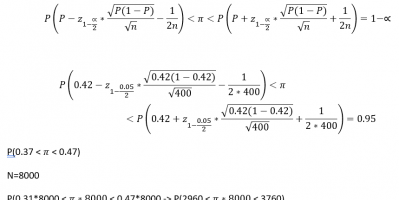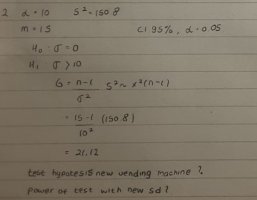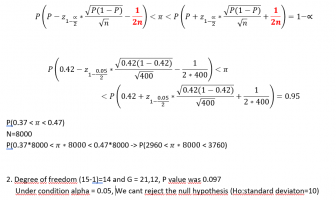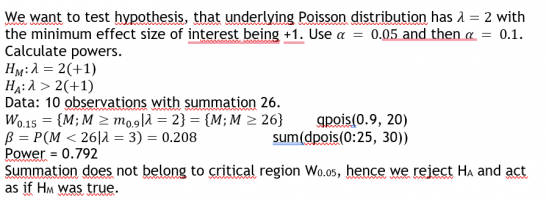Hello,
I'm working on my homework, if you have free time, please kindly check my work.
Thank you,
Here's the problem:
1. We asked at the poll 400 voters if they voted for party A. 168 of them responded that they did. Estimate the absolute number of voters of this party assuming, that there are 8 000 voters. Use 95 % confidence level and continuity correction. (I'm done with this part). Assume the null hypothesis to be that the party has 50 % or more voters and the minimal effect size of interest is 10 percentage points. What is the power of the test assuming minimal effect size? What is the decision of the test? (I don't know how to do this one).

2. Accuracy of a coffee vending machine is given by standard deviation equal to 10 ml. A new vending machine was bought. Test the hypothesis, that the new vending machine is less accurate (s.d. is larger) than was the old one, if we measured among 15 randomly chosen cups of coffee sample´s variance 150.8. What is the power of the test if the true new standard deviation is, consequently, 12, 14 or 16 ml? (My work has been posted below, please kindly check it)
Thank you, freemathhelp!
I'm working on my homework, if you have free time, please kindly check my work.
Thank you,
Here's the problem:
1. We asked at the poll 400 voters if they voted for party A. 168 of them responded that they did. Estimate the absolute number of voters of this party assuming, that there are 8 000 voters. Use 95 % confidence level and continuity correction. (I'm done with this part). Assume the null hypothesis to be that the party has 50 % or more voters and the minimal effect size of interest is 10 percentage points. What is the power of the test assuming minimal effect size? What is the decision of the test? (I don't know how to do this one).

2. Accuracy of a coffee vending machine is given by standard deviation equal to 10 ml. A new vending machine was bought. Test the hypothesis, that the new vending machine is less accurate (s.d. is larger) than was the old one, if we measured among 15 randomly chosen cups of coffee sample´s variance 150.8. What is the power of the test if the true new standard deviation is, consequently, 12, 14 or 16 ml? (My work has been posted below, please kindly check it)
Thank you, freemathhelp!




